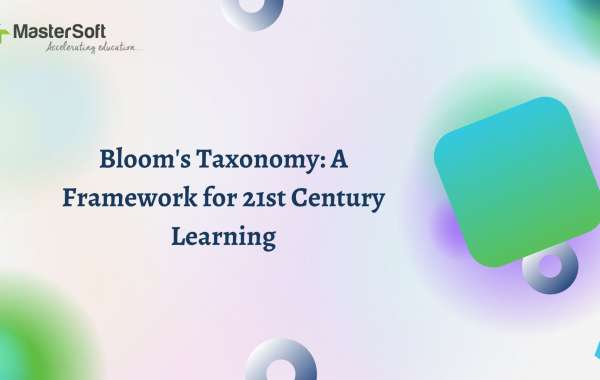In the ever-evolving landscape of education, fostering effective learning environments that prepare students for the challenges of the 21st century is paramount. Educators strive to create lessons that inspire critical thinking, problem-solving, and deep comprehension. Understanding and applying Bloom's Taxonomy is fundamental for educators aiming to create meaningful learning experiences and facilitate student success. In this comprehensive guide, we will delve into the various aspects of Bloom's Taxonomy, its significance, and how it can be effectively applied to create a framework for 21st century learning.
What is Bloom's Taxonomy?
Bloom's Taxonomy is a classification system that divides educational objectives into three domains: Cognitive, Affective, and Psychomotor. Developed by Benjamin Bloom in collaboration with a group of educational psychologists, the model was first presented in 1956 in the book Taxonomy of Educational Objectives: The Classification of Educational Goals. The original model focused solely on the Cognitive Domain, which consists of six levels: Remembering, Understanding, Applying, Analyzing, Evaluating, and Creating.
The Cognitive Domain:
- Remembering: This level involves recalling or recognizing facts, concepts, or answers.
- Understanding: Here, the learner can comprehend the meaning, interpretation, or translation of knowledge.
- Applying: This level requires the use of learned material in new and concrete situations.
- Analyzing: At this stage, the learner can break down material into its component parts to understand its organizational structure.
- Evaluating: Learners at this level are able to make judgments about the value of ideas or materials.
- Creating: This is the highest level of the taxonomy, where learners can put together different ideas to form new concepts or products.
The Significance of Bloom's Taxonomy
Bloom's Taxonomy provides educators with a clear framework for developing learning objectives and assessments that target different levels of cognitive complexity. By using Bloom's Taxonomy, teachers can ensure that their lessons align with higher-order thinking skills and promote deeper understanding rather than rote memorization. Here’s why Bloom's Taxonomy is significant:
1. Promotes Higher-Order Thinking:
Bloom's Taxonomy encourages the development of higher-order thinking skills such as analysis, synthesis, and evaluation. By moving beyond simple remembering and understanding, educators can foster critical thinking and problem-solving abilities in students.
2. Guides Instructional Design:
By incorporating Bloom's Taxonomy into lesson planning, educators can design more effective and engaging learning experiences. The taxonomy provides a roadmap for creating learning objectives that progressively build upon one another, leading to deeper understanding and mastery.
3. Facilitates Differentiated Instruction:
Bloom's Taxonomy allows educators to differentiate instruction to meet the diverse needs of students. By varying the level of cognitive demand, teachers can provide appropriate challenges for each learner, ensuring that all students have the opportunity to succeed.
4. Encourages Meaningful Assessment:
Bloom's Taxonomy serves as a guide for creating assessments that measure student learning at different levels of cognitive complexity. By aligning assessments with learning objectives, educators can accurately gauge student understanding and provide targeted feedback.
5. Prepares Students for Real-World Challenges:
By focusing on higher-order thinking skills, Bloom's Taxonomy helps prepare students for the complex challenges they will face in the real world. By engaging in activities that require analysis, evaluation, and creation, students develop the skills they need to be successful in college, careers, and beyond.
Bloom's Taxonomy: A Framework for 21st Century Learning
In the 21st century, students need more than just knowledge; they require critical thinking skills, adaptability, and the ability to apply their knowledge to real-world situations. Bloom's Taxonomy provides a framework for educators to meet these needs and prepare students for success in an ever-changing world.
1. Remembering:
At this level, teachers can incorporate activities such as:
- Quizzes
- Flashcards
- Recitation
- Labeling
Example: In a history class, students might be asked to recall key dates or events from a particular time period.
Creating a Framework for 21st Century Learning: Utilize digital flashcards or online quizzes, turning the learning process into a game. Encourage competition and teamwork among students to make the remembering process more engaging. Incorporate multimedia resources and gamification to make learning memorable and enjoyable.
2. Understanding:
To promote understanding, educators can use activities such as:
- Summarizing
- Paraphrasing
- Explaining
- Classifying
Example: In a science class, students might be asked to explain the process of photosynthesis in their own words.
Creating a Framework for 21st Century Learning: Organize group discussions where students are encouraged to explain concepts to each other. This not only reinforces their understanding but also fosters an interactive learning environment. Integrate technology, such as interactive simulations or virtual labs, to enhance students' understanding of complex concepts.
3. Applying:
Activities that promote the application of knowledge include:
- Solving problems
- Conducting experiments
- Using models or simulations
- Applying concepts to real-world scenarios
Example: In a math class, students might be asked to solve word problems that require them to apply the Pythagorean theorem.
Creating a Framework for 21st Century Learning: Create real-world scenarios or simulations relevant to the subject matter. For instance, in a language class, students could create dialogues or skits using vocabulary and grammar rules they've learned. Encourage project-based learning where students can apply their knowledge to solve real-world problems or challenges.
4. Analyzing:
To encourage analysis, teachers can use activities such as:
- Comparing and contrasting
- Identifying patterns or trends
- Deconstructing
- Organizing
Example: In an English class, students might be asked to analyze the themes of a novel or identify the author's use of literary devices.
Creating a Framework for 21st Century Learning: Use multimedia tools such as video clips, animations, or infographics to present complex topics. Then, encourage students to analyze and interpret the multimedia content, fostering a dynamic and interactive learning environment. Implement project-based learning where students can analyze data, conduct experiments, or evaluate information to solve real-world problems.
5. Evaluating:
Activities that promote evaluation include:
- Debating
- Critiquing
- Defending a position
- Formulating opinions
Example: In a social studies class, students might be asked to evaluate the effectiveness of a particular government policy.
Creating a Framework for 21st Century Learning: Implement Socratic seminars or debates on topics related to the subject matter. This encourages students to think critically, defend their opinions, and respectfully evaluate others’ points of view. Encourage students to use evidence and reasoning to support their opinions and to consider multiple perspectives when evaluating information.




